Teruel Segundo de Chomon y Ruiz (1871-1929) was an Aragonese film pioneer who worked in Paris for Pathe from 1905-1910. His association with Pathe began in 1901 when from Barcelona he hand-tinted Pathe releases, & his own earliest works from 1902 were distributed in France by Pathe.
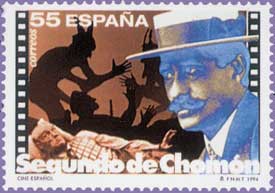 He moved to Paris to assist other pioneer filmmakers & continued as well to make films of his own. He invented the "film dolly" in 1907 while at Pathe. The films on which he is credited as photographer really amount to co-direction. He also wrote scripts for other directors as well as for his own films. He moved to Paris to assist other pioneer filmmakers & continued as well to make films of his own. He invented the "film dolly" in 1907 while at Pathe. The films on which he is credited as photographer really amount to co-direction. He also wrote scripts for other directors as well as for his own films.
He returned to Barcelona in 1910 where he worked with Juan Fuster on several short-shorts, & in 1911 made travel documentaries in Spain for Pathe & briefly ran his own film company called Iberica, with Pathe as his distributor.
By 1912 he was in Italy as an FX specialist for Italia Film Co., his most important work in this period being director of photography & special FX for the seminal epic of the ancient world Cabiria (1914). In Italy he also directed animated shorts of his own.
From 1901 onward he was always devising new methods of more rapidly tinting films for full color effect, & was the primary technician in developing "Pathechrome" which in 1905 Charles Pathe patented.
Pathechrome was the first mechanical tinting device, permitting each color to be stamped onto a film frame with a stencil through which dye passed from a dyed ribbon. It was still largely a labor-intensive process & it wasn't quite as good as the best hand-tinting jobs.
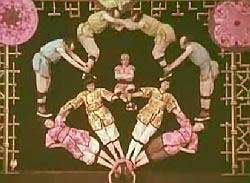 Segundo de Chomon was always strongly desirous of making color films, but the necessity of hand-tinting or stencilling every frame of every copy made it difficult to impossible to make longer movies.
Segundo de Chomon was always strongly desirous of making color films, but the necessity of hand-tinting or stencilling every frame of every copy made it difficult to impossible to make longer movies.
In 1923 he returned to Paris, & was again associated with the best filmmakers of the time, including all the camera FX for Abel Gance's Napoleon (1927).
With Ernest Zollinger of Switzerland he was the co-inventor of a two-color film process & toward the end of his career he would focus on making two-color films until his unexpected death in 1929 following a filmmaking journey to Morocco.
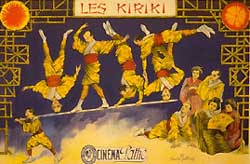 A visually pleasing example of Chomon's devotion to creating a "color" experience" is Les Kiriki: Acrobates Japonois (1907). With his obsession for color he creates a stunning color pallette for an otherwise minor effort. A visually pleasing example of Chomon's devotion to creating a "color" experience" is Les Kiriki: Acrobates Japonois (1907). With his obsession for color he creates a stunning color pallette for an otherwise minor effort.
It shows a group of dancers pretending to be Japanese acrobats (wearing absurdly incorrect samurai hairstyle wigs).
In Kiriki the acrobats perform some fairly amazing stunts, except that they're really laying on their backs rather than standing when they do this stuff.
Except for affecting to be Japanese, this is pretty much a rip-off of the central visual trick in Georges Melies An Impossible Balancing Feat (L'Equilibre Impossible, 1902), in which a magician arranges double-exposure versions of himself in impossible acrobatic balancing act.
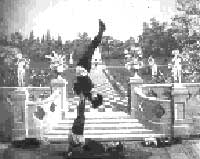 So the cleverness of the overhead shot to fake the balancing act belongs to Melies rather than Chomon, & Chomon actually simplified the method by not requiring multiple exposures of the film. So the cleverness of the overhead shot to fake the balancing act belongs to Melies rather than Chomon, & Chomon actually simplified the method by not requiring multiple exposures of the film.
Chomon has recreated the Melies trick to be charmingly phony, & it's a lot more entertaining than the Edison Manufacturing Company's Japanese Acrobats (1904).
Superficially the same subject matter, at a minute & three-quarters the Edison film features actual Japanese acrobats on a stage before an ornate backdrop, doing amazing stunts for real.
The acrobats are a lot more impressive than the fake ones of Chomon's later film, but Chomon's fakery adds that aesthetic ingredient.
For a long time Chomon was so strongly imitative of Georges Melies that his own originality was subdued. In the colorful hand-tinted The Cigar Box (La Boite a cigares; aka, La Caja de puros, 1907) he devises scenarios that too greatly resemble Melies.
A chap looking like one of the three musketeers steps out of a giant humidor or magical device. A number of girls dressed as pages appear by trick photography around the edges of the humidor, which turns about like a merry-go-round. The girls then leave the stage.
The magician-musketeer with great flourish causes the walls of the humidor to collapse, revealing five enormous cigars, which he lights with his musket just before they turn into the girls dressed as pages.
Raising the humidor's walls back up, the maidens appear again, this time in dresses, & do a little can-can. Next from the humidor come several dandies in powdered wigs, then court ladies in long gowns.
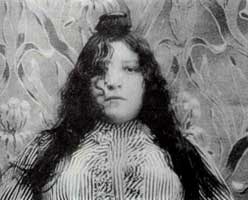 It's getting awfully redundant as the girls appear again from the humidor in new costumes, then the musketeer covers himself with a blanket & vanishes, returning stage right to make something of a maypole out of the collapsed humidor, with maidens dancing round & round. It's getting awfully redundant as the girls appear again from the humidor in new costumes, then the musketeer covers himself with a blanket & vanishes, returning stage right to make something of a maypole out of the collapsed humidor, with maidens dancing round & round.
The witty b/w silent The Electric Hotel (El Hotel Elettrico, 1905) clocks in at seven minutes. The copy I watched was very fuzzy & worn but still it's brilliance shows through.
When Chomon was being most original, he had a greater poker-face than Melies & went for awe & beauty rather than the comedic. But for The Electric Hotel he adheres to comic fantasy in the manner of Melies.
Qualifying as early science fiction, the latest in hotel experience is complete automation. While a man & wife (Segundo himself, with his actual wife Julienne Mathieu) check in, their suitcases travel under their own power to their room. Their bags unpack themselves before our couple reaches their room.
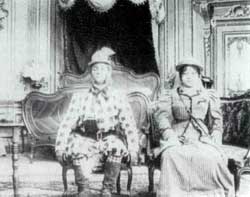 The woman is clad in conservative long dress of the age, but the guy is wearing a wacky spotted knickers outfit & ridiculous hat to underscore the absurd. The woman is clad in conservative long dress of the age, but the guy is wearing a wacky spotted knickers outfit & ridiculous hat to underscore the absurd.
The gentleman seats himself for an automatic shoe-shining from an animated shoe-brush.
He also gets an automated shave from flying shaving brush & razor, & his hair trimmed nicely.
The lady meanwhile has her coat & hat taken automatically from her & put away. She seats herself in a chair that moves her into better light.
An automatic brush takes down her hair, brushes it out, & puts it back kup for the night. The stop motion technique is extremely well done.
But in the basement, due to a drunkard at the control panels, the electrical dynamo is short circuited. Our couple's room begins to shift wildly, all the furnishings becoming dangerously mobile, the alarmed couple riding round & round on crazily active furnishings.
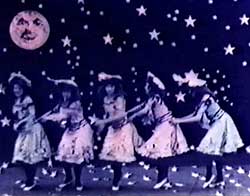 On the ledge of the crescent moon, in the punningly titled Les Lunatiques (1908), a moon-woman shakes a Pierot costume & manifests a Pierot clown.
On the ledge of the crescent moon, in the punningly titled Les Lunatiques (1908), a moon-woman shakes a Pierot costume & manifests a Pierot clown.
She does this four more until there are five Pierots crowded on the ledge of the moon. They fall to the earth (the moon now full above them) & dance like tops turning one by one into Columbine maidens.
As they dance they keep turning into other sets of five including five Chinese guys, five blackface picaninnies, five blackface guys in tophats.
This one starts really well following the manner of Melies' stellar-journey comedies, with gorgeous hand-tint color. But by the time dancers are turning to race stereotypes, it's lost all power.
Bob's Electric Theater (Le Theatre de Bob, 1906) was written by Ferdinand Zecca & directed by Chomon, reversing their association on Down in the Deep (Le Pecheur de perles, 1904) written by Chomon & directed by Zecca.
Three children are relaxing, studying, or playing in their room, two lads & their sister. The lads are suddenly eager to put on a theatrical piece & set up their puppet-stage, onto which by stop-motion animation a tiny carpet unroles, & two boy dolls walk out onto the carpet to play. Their play turns serious as they take up swords & duel to the death.
The curtain falls & rises, & the same two dolls stride out for a second performance this time as boxers, battling ferociously, then bowing & leaving the stage. Curtain falls, rises, & for Act 3 a chair brings itself out & one the dolls comes forth, one to sit in in the chair. The second doll follows & they have soon begun to perform acrobatic wrestling.
Curtain down, up, act four begins with parallel bars bringing themselves out. A different doll, this one an adult, strides out & performs on the bars then does a few other foolish stunts. The show ends, the carpet rolls itself back up & leaves the stage.
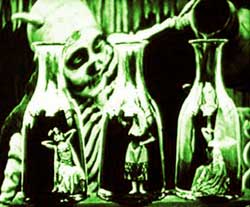 A nice early example of stop motion animation, the lack of even a rudimentary story does not give this one a high rating, but it's prettily done, hand-tinted as so many of Chomon's films. A nice early example of stop motion animation, the lack of even a rudimentary story does not give this one a high rating, but it's prettily done, hand-tinted as so many of Chomon's films.
As the colorful hand-tinted Satan's Amusement (Satan S'Amuse, 1907) opens, a coffin in flames stands uprights, bursts open, & there stands Satan!
With a flourish of his kingly robe he swaggers about in his cavern & in a burst of flame & smoke causes five women to materialize & dance for him in a circle. They then turn into floating flames, one of which Satan captures & uses like a wand to produce two braziers of flame that turn back into maidens.
The devil's magic act continues with sundry bits of legerdemane all done in abject seriousness & resembling a live stage act performed by a guy in a devil suit. He wraps one maiden then the next in sheets of plastic, levitates them, then makes them vanish.
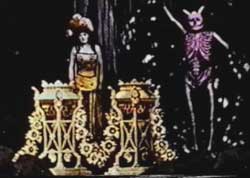 He brings forward three bottles on a stand with a tiny woman in each & turns them into milk, the coolest of all the devil's tricks, of which he still has a few to go. He brings forward three bottles on a stand with a tiny woman in each & turns them into milk, the coolest of all the devil's tricks, of which he still has a few to go.
Throughout his act, he has a pushy female assistant (Julienne Mathieu) who he seems unable to fully control. She does help in his act, but with lots of attitude. Her presence seems to be intended as comic relief to the serious act.
There are some truly striking images in this devilish film but it does not seem genuinely about a devil who does magic but remains mainly a magician dressed as a devil.
His act seems to have nothing to do with punishments of Hell, except when he did his best milk bottle maidens tricks. The women who assist in his act seem otherwise to be having a delightful time.
At the end, his assistant wrestles him to the ground & destroys all but his cape, which she puts on! Apparently while Satan was perfecting his magic act, Lilith was effecting a coup.
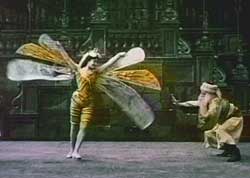 The Golden Scarob; aka, The Golden Beetle (Le Scarobee d'or, 1907) at three minutes length is also in full color. As the tale opens, a Muslim is either bowing to Mecca, or to the audience. He then materializes a brazen bowl of fire over which a maiden in colorful insect wings appears.
The Golden Scarob; aka, The Golden Beetle (Le Scarobee d'or, 1907) at three minutes length is also in full color. As the tale opens, a Muslim is either bowing to Mecca, or to the audience. He then materializes a brazen bowl of fire over which a maiden in colorful insect wings appears.
She sinks with wings spread into a fountain that replaced the brazen bowl. The Muslim mystic crawls about for a while until the fountain bursts into colorful fireworks. The scarab-maiden appears amidst the flame with two wingless assistants, who help lower her to the ground, the fiery fountain having now vanished.
Maiden-scarab & mystic circle one another then the mystic climbs into the brazen bowl & vanishes. The maiden-scarab climbs in the bowl & displays herself with wings full spread.
That's all there is to it. Although it is easy to imagine this being one of Melies' short-short films abiyt sorcerers, Melies would most likely have made it comical, whereas Segundo de Chomon strives for aesthetic beauty.
copyright © by Paghat the Ratgirl
|
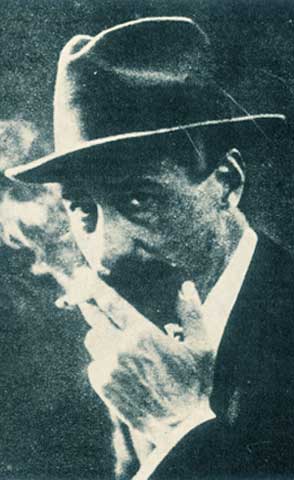
 He moved to Paris to assist other pioneer filmmakers & continued as well to make films of his own. He invented the "film dolly" in 1907 while at Pathe. The films on which he is credited as photographer really amount to co-direction. He also wrote scripts for other directors as well as for his own films.
He moved to Paris to assist other pioneer filmmakers & continued as well to make films of his own. He invented the "film dolly" in 1907 while at Pathe. The films on which he is credited as photographer really amount to co-direction. He also wrote scripts for other directors as well as for his own films.
 A visually pleasing example of Chomon's devotion to creating a "color" experience" is Les Kiriki: Acrobates Japonois (1907). With his obsession for color he creates a stunning color pallette for an otherwise minor effort.
A visually pleasing example of Chomon's devotion to creating a "color" experience" is Les Kiriki: Acrobates Japonois (1907). With his obsession for color he creates a stunning color pallette for an otherwise minor effort. So the cleverness of the overhead shot to fake the balancing act belongs to Melies rather than Chomon, & Chomon actually simplified the method by not requiring multiple exposures of the film.
So the cleverness of the overhead shot to fake the balancing act belongs to Melies rather than Chomon, & Chomon actually simplified the method by not requiring multiple exposures of the film. It's getting awfully redundant as the girls appear again from the humidor in new costumes, then the musketeer covers himself with a blanket & vanishes, returning stage right to make something of a maypole out of the collapsed humidor, with maidens dancing round & round.
It's getting awfully redundant as the girls appear again from the humidor in new costumes, then the musketeer covers himself with a blanket & vanishes, returning stage right to make something of a maypole out of the collapsed humidor, with maidens dancing round & round. The woman is clad in conservative long dress of the age, but the guy is wearing a wacky spotted knickers outfit & ridiculous hat to underscore the absurd.
The woman is clad in conservative long dress of the age, but the guy is wearing a wacky spotted knickers outfit & ridiculous hat to underscore the absurd.
 A nice early example of stop motion animation, the lack of even a rudimentary story does not give this one a high rating, but it's prettily done, hand-tinted as so many of Chomon's films.
A nice early example of stop motion animation, the lack of even a rudimentary story does not give this one a high rating, but it's prettily done, hand-tinted as so many of Chomon's films. He brings forward three bottles on a stand with a tiny woman in each & turns them into milk, the coolest of all the devil's tricks, of which he still has a few to go.
He brings forward three bottles on a stand with a tiny woman in each & turns them into milk, the coolest of all the devil's tricks, of which he still has a few to go.